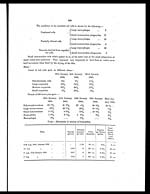Medicine - Institutions > Army health reports and medical documents > Scientific memoirs by officers of the Medical and Sanitary Departments of the Government of India > Number 35 - Black-water fever > Part VI
(210) Page 198
Download files
Individual page:
Thumbnail gallery: Grid view | List view

198
Emulsion of washed corpuscles hæmolysed by Class A. serum. Antibody 20 c.m. not que
protective against 150 c.m. S.R.C. serum.
Examination of splenic blood taken 4½ hours after passing the first sample of urine.
No malarial parasites.
Pigment (simple tertian) in endothelial cells and mononuclear leucocytes.
Phagocytosis of altered and apparently normal red blood corpuscles a very conspicuous fea-
ture. Small cells with crescentic nuclei containing each a single often quite normal looking
blood corpuscle are abundant. These cells have but little protoplasm and what there is
is extended around the engulfed cell.
In some of the cells the protoplasm shews some fine red granules. The cells vary some-
what in size, the larger ones approaching in appearance mononuclear leucocytes but the most
numerous are small and nearly globular in shape.
The included red cells are generally quite unaltered a little paler than the free cells in the
eighbourhood; others are pale with a faint yellowish tinge or show a rim of darker staining
substance around the periphery. The closest scrutiny failed to show in these cells either
malarial parasites or any indication of contained bodies.
Cells resembling these are seen, which in spite of the small quantity of protoplasm they
possess have engulfed two, three, or even four red cells, and others of the same type are seen
packed with a dozen or more red cells in various stages of decolouration.
Of macrophages there are two types :—
1. Cells of the nature of those just described which appear to be free cells and are gen-
erally more or less globular.
2. Large endothelial plaques often having two nuclei and containing besides red cells
various vacuoles and included masses.
In both types of cell the red cells vary from normal to small dark cells and cells in various
degrees decolourised.
Occasionally a shrunken cell of a greenish tinge is seen. A differential count of 2,200 cells
in the spleen gave :—
| Large macrophages | 5.5% |
| Small mononuclear cells of various types | 49.8% |
| Large mononuclears leucocytes | 4.4% |
| Polymorphonuclear leucocytes | 13.7% |
| Eosinophile leucocytes | .7% |
| Large cells with basophilic protoplasm | 1.8% |
| Cells of doubtful nature, free nuclei, etc. | 24.0% |
| 99.9% | |
| Large macrophages containing red cells | 1.7% |
| Small mononuclear cells containing red cells | 1.3% |
Set display mode to: Large image | Zoom image | Transcription
Images and transcriptions on this page, including medium image downloads, may be used under the Creative Commons Attribution 4.0 International Licence unless otherwise stated. ![]()
| Permanent URL | https://digital.nls.uk/75060872 |
|---|
| Description | Appendix |
|---|
| Shelfmark | IP/QB.10 |
|---|---|
| Additional NLS resources: | |




